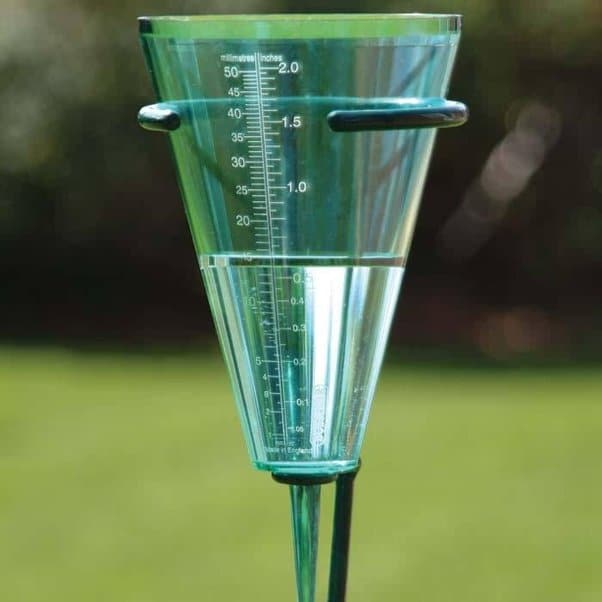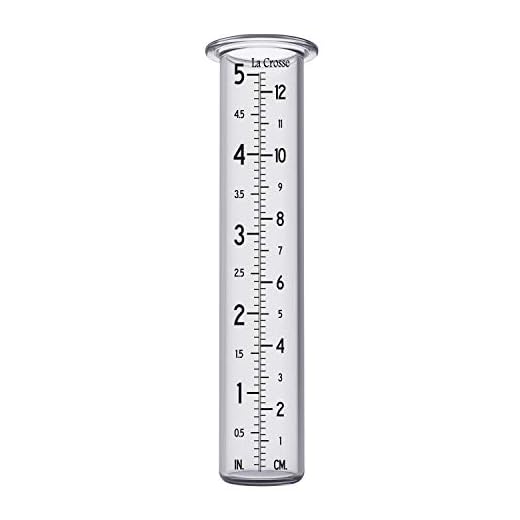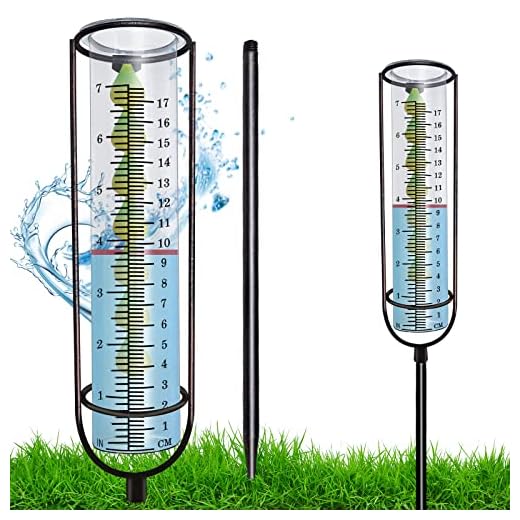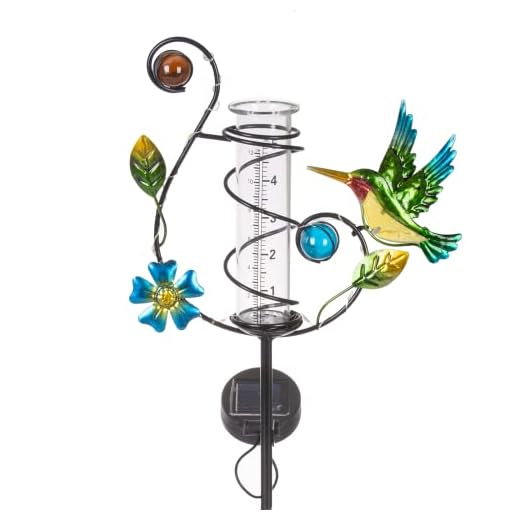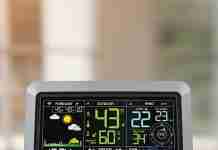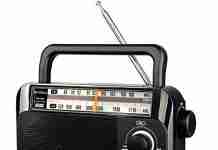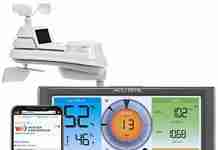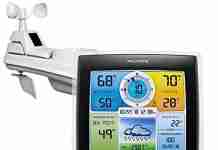Have you ever wanted to measure the amount of rainfall in your area? If so, you may want to consider using a rain gauge.
A rain gauge is an instrument used to measure rainfall over some time. It can be easily set up in any backyard or garden, providing accurate readings of how much rain has fallen.
In this article, we will explain how to use a rain gauge to measure rainfall at home.
Rain gauges come in many different sizes and shapes, but they all work the same way. The most common type is called an “accumulating” rain gauge; it measures rainfall by collecting drops of water in a container and then measuring the total volume of water collected.
Other types include tipping bucket rain gauges which measure cumulative amounts by counting each drop as it falls into the container. No matter which types you choose, setting one up at home is easy and requires minimal effort.
Knowing how much rainfall your area receives can be extremely helpful for planning outdoor activities or gardening projects.
With the help of a rain gauge, you can accurately monitor precipitation levels in your area and use that information for various purposes.
In this article, we’ll explain how to set up and use a rain gauge at home so that you can begin tracking rainfall as soon as possible!
Review contents
Definition Of A Rain Gauge
A rain gauge is an instrument used to measure the amount of rainfall in a given area. It is also known as a precipitation gauge, whose purpose is to measure rainfall or any other form of precipitation.
Rain gauges are typically made of plastic, metal, or glass and are designed to accurately measure the amount of water that falls from the sky over a certain period.
Generally speaking, a rain gauge consists of a funnel-shaped device that collects rainwater and then funnels it into a measuring cylinder.
This cylinder allows for precise measurements to determine the exact amount of rainfall.
The definition of precipitation refers to all forms of water droplets that fall from the sky, including rain, snow, hail, sleet, and even fog.
Therefore, when using a rain gauge to measure the amount of rainfall over a particular period, it is essential to remember that all forms of precipitation should be accounted for.
Rain gauges are essential for collecting data on weather patterns and climate change since they accurately measure how much water falls from the sky at any moment.
As such, they are often used by meteorologists and other professionals who study weather patterns regularly. Moving forward, we will discuss the purpose of using a rain gauge for individuals at home.
Purpose Of Using A Rain Gauge
A rain gauge is used to measure and record rainfall accurately. It can help you better understand your area’s weather patterns and how rainfall can affect them.
Rain gauges are used by meteorologists, farmers, and other professionals who need accurate precipitation measurements to make decisions. A rain gauge is also great for collecting data on local weather patterns over time for home use.
A rain gauge will precisely measure how much rainfall you receive daily or monthly. This information can be helpful when planning outdoor activities like gardening or landscaping.
Knowing the amount of precipitation in your area over time can also help you prepare for possible flooding or drought conditions ahead of time.
Rain gauges are an essential tool for measuring and understanding the impacts of rainfall on your environment.
Not only do they provide accurate measurements, but they also allow individuals to keep track of their local weather patterns over long periods. This data can help plan activities or take precautions during certain weather conditions.
By understanding what’s happening with local rainfall, individuals can better manage their environment and protect themselves from potential hazards associated with extreme weather events.
Transitioning smoothly into the next section about types of rain gauges, various options are available depending on each situation’s specific needs and uses.
Types Of Rain Gauges
When it comes to measuring rain, several different types of rain gauges are available for home use.
These range from simple and inexpensive tools to more sophisticated and expensive models. Accuracy is the most crucial factor when choosing the correct rain gauge.
Here are four common types of rain gauges used for accurate rainfall measurements at home:
- Standard Rain Gauge – This is the most basic type of rain gauge, often found in hardware stores or garden centers. It is typically made of plastic or metal and uses a graduated cylinder to measure rainfall amounts up to 5 inches.
- Tipping Bucket Rain Gauge – This rain gauge measures tiny amounts of rainfall with increased accuracy. It works by tipping over when a certain amount of rain has collected, activating a switch that records the amount of precipitation that has fallen.
- Automatic Rain Gauge – This type of instrument is designed to record and store data related to rainfall over time so that long-term trends can be tracked and analyzed accurately. Automatic rain gauges are often used for research purposes but are becoming increasingly popular with homeowners who want to track their local weather patterns more closely.
- Wireless Rain Gauge – As its name suggests, this type of gauge uses wireless technology to transmit data from an outdoor location directly to a computer or smartphone app in real time, allowing users to monitor their local weather conditions in detail from anywhere in the world!
No matter which type you choose, having a reliable home rain gauge can help you stay informed about current weather patterns and be prepared for what’s ahead – sunny skies or stormy days ahead!
Choosing the right one will help ensure you get accurate readings so you can make informed decisions about how best to protect your property when Mother Nature decides it’s time for some wet weather!
Choosing The Right Rain Gauge
When measuring rainfall at home, choosing the correct rain gauge for accurate data is essential. Several types of rain gauges are available, each suited for different weather conditions and measurement levels.
The most common type of rain gauge is the simple cylindrical rain gauge, which can measure up to 1 inch of rainfall in a given area. This type of rain gauge works best when low amounts of precipitation are expected and during dry weather conditions.
A funnel-style gauge should be used for more significant amounts of rainfall or areas that experience heavy rains, as it can measure up to 10 inches.
This gauge type is also more accurate when measuring rainfall over long periods or in areas where high winds often occur.
Knowing the amount and frequency of rainfall in an area can help determine which type of rain gauge will provide the most accurate data.
Once the correct rain gauge has been chosen, setting it up at home will allow one to measure the amount of rainfall they receive over time.
Setting Up A Rain Gauge At Home
Setting up a rain gauge at home is essential to measuring rainfall. To begin, you’ll need to purchase a rain gauge.
Once you have the rain gauge, the next step is to install it correctly. It’s essential to place your rain gauge in an area with no obstructions that could interfere with rainwater entering the container. The most accurate reading will be obtained if the container’s rim is at least two feet above ground level and facing southward.
You’ll also want to ensure that any trees or structures are at least ten feet away from the container to avoid interference from wind or sheltering from other objects.
Next, you must connect the rain gauge to a post or tripod for stability. If attaching it directly to your lawn, use a post-hole digger or metal spike for support. For further stability, drill a hole in one corner of the base and secure your rain gauge with screws and nuts or bolts.
Finally, you should test your setup by pouring water into the container until it reaches its maximum capacity. This will help ensure that your installation is properly functioning and help determine how much water is needed before readings need to be taken and recorded.
Following these steps, you can easily set up a reliable home rain gauge for measuring rainfall accurately and efficiently.
Recording Measurements From A Rain Gauge
Using a rain gauge to measure rainfall at home is essential in understanding weather conditions and precipitation.
To accurately record the measurements, purchase or build a rain gauge that can be placed outside your home. Make sure to place it away from trees or other obstructions so that the data you collect is accurate.
When measuring rainfall, observe the readings of your rain gauge at least once a day and record them on paper or digitally.
It’s essential to note any inconsistencies between consecutive readings, as these could indicate an issue with your rain gauge recording.
If you notice any discrepancies, double-check your rain gauge’s accuracy and ensure it’s positioned adequately before continuing with the measurements.
Finally, use the data collected from your home rain gauge to understand how much rainfall occurs in your area over time. This will help you better plan outdoor activities and prepare for upcoming storms or inclement weather.
Transitioning into understanding weather conditions and precipitation, consider consulting local forecasts and tracking changes in atmospheric pressure to stay informed about potential shifts in weather patterns.
Understanding Weather Conditions And Precipitation
Weather conditions and precipitation patterns can be complex and vary from region to region. When forecasting the weather, it’s essential to consider factors such as rain intensity, humidity levels, and climate change.
These are necessary to predict the amount of precipitation in a given area.
An accurate rain gauge is essential to measure rainfall in your home. Rain gauges measure the water falling from the atmosphere as rain or snow. They are typically small containers with calibrated scales that allow you to measure the amount of rainfall precisely.
Rain gauges come in many shapes and sizes, making them suitable for various applications, including professional weather stations and home use.
Knowing how much rainfall your area receives will help you better understand local weather conditions and track changes that may be related to climate change over time.
What Affects Measurements?
Using a rain gauge to measure rainfall at home can accurately gauge the amount of precipitation that falls in an area.
However, some other factors can affect the measurements obtained from a rain gauge.
Here are five key points that should be taken into consideration when measuring rainfall with a rain gauge:
- Humidity levels
- Temperature variations
- Wind speed
- Altitude changes
- Barometric pressure
Humidity levels affect how much water vapor is in the air and can influence measurement accuracy. Temperature variations also play a role, as warmer temperatures cause more evaporation, leading to less accurate measurements.
Wind speed affects how far away moisture will travel and settle on the rain gauge’s surface. Altitude changes can impact where moisture settles due to density differences in the atmosphere.
Lastly, barometric pressure influences how much water vapor is held in the atmosphere and affects rain measurement accuracy.
By considering these factors when measuring rainfall with a rain gauge, you can get more accurate readings. This information will help you calculate your area’s average monthly and annual rainfall.
Calculating Average Monthly And Annual Rainfall
You’ll need to collect data from your rain gauge over time to calculate average monthly and annual rainfall. Start by recording the daily measurements from your rain gauge in a spreadsheet or journal.
To calculate the average monthly rainfall, add the total amount of rainfall for each month and divide it by the number of days in that month.
To calculate annual rainfall, divide each year’s total amount of rainfall by 12 months. It is important to note that these calculations are only estimates since actual conditions may vary daily and yearly.
Now that you have collected rain data, you can use this information to calculate your rain totals. By summarizing your data over long periods, you can begin to track trends in your local climate and observe how much water has fallen over a particular area. This information can be used to plan for upcoming weather events or seasonal changes.
In addition to calculating average monthly and annual rainfall totals, tracking rain data allows you to compare patterns in past years with current years and identify any environmental anomalies that may affect future weather patterns.
Knowing typical rainfall amounts at any location helps people better prepare for extreme weather events like floods or droughts.
With this knowledge, homeowners can ensure their properties remain safe during severe weather conditions and make informed decisions regarding their water usage.
Benefits Of Measuring Rainfall At Home
Having a rain gauge at home to measure rainfall is beneficial for various reasons.
It can help track local weather patterns, provide environmental data, and even inform decisions about rainwater harvesting or other water-related activities.
- Track Rainfall Trends: Measuring rainfall at home allows you to track rainfall trends over time, indicating how much rain has fallen in a specific area during any given period. This data can be used to plan for storms or floods or understand the weather pattern. Here are some key benefits of measuring rainfall at home:
- Monitor Local Weather Conditions: Measuring rainfall at home allows you to monitor local weather conditions and make more informed decisions based on collected data. For example, suppose there is a dry period in your area. In that case, you can use the information collected from your rain gauge to determine if water conservation measures need to be taken or if further steps should be taken to protect the environment.
- Obtain Accurate Rain Data: Accurate and reliable data can help you make better decisions when using natural resources such as water. You can determine the best times for watering plants and crops with accurate rain data or plan for potential flooding events.
Using a rain gauge is an easy way to measure rainfall and collect critical environmental data that can be used for various purposes.
Additionally, with technological advances, automated measurement, and data collection systems are becoming increasingly popular and accessible for homeowners who want to keep track of their local weather conditions without manually checking the rain gauge daily.
Using Technology To Automate Measurement And Data Collection
Using technology to automate measurement and data collection can make measuring rainfall at home much more accessible. Rain gauge technology can accurately measure the amount of rainfall in a given area over time.
This makes it possible for people to know exactly how much rain fell in their area without going out and checking manually. The use of tech automation can also help streamline data collection, making it easier to store and analyze the collected information.
In addition, tech automation can be used to set up an automated system to take measurements and transmit them to designated devices or applications.
This allows users to quickly access real-time data regarding rainfall in their area without actively collecting it themselves. This is especially useful for those who want to keep track of their rainfall measurements over time.
Tech automation allows individuals to accurately monitor rainfall levels at home with minimal effort. This helps ensure that accurate readings are taken so people can understand how much rain has fallen in their area.
With this information, they can better plan for potential flooding or water shortages due to long periods of no rain.
From here, they can move on to interpreting the results from their home rain gauge and taking appropriate action based on those results.
Interpreting Results From A Home Rain Gauge
Interpreting the results from a home rain gauge can help you better understand rainfall patterns in your area and make more accurate predictions of future rainfall amounts.
Recording as much data as possible over an extended period is essential to get the most out of your rain gauge analysis. This will allow you to track seasonal changes in rainfall and spot any long-term trends in the data.
When analyzing your results, use graphs and statistical models to visualize the data and identify any significant patterns or fluctuations in rainfall amounts.
Once you’ve collected enough data, you can start making more informed decisions about how water is used around your home. For instance, if certain months are dryer, you might want to conserve water by collecting rainwater for gardening or other activities.
Similarly, if areas on your property consistently experience higher precipitation levels, this could be helpful information when planning a garden or landscaping project.
Analyzing your observations from a home rain gauge can also provide valuable insights about climate change. By comparing current records with historical measurements taken over the same period, it is possible to detect changes in local weather patterns due to global warming or other factors.
With this information, homeowners can make better choices about using energy and resources around their property and help reduce their overall environmental impact.
This data collected from a rain gauge can provide valuable insights into understanding regional rainfall patterns and help homeowners make more informed decisions about water usage around their homes.
Additionally, analyzing these readings may give us clues into climate change and its environmental effects by comparing current records with past measurements.
How To Use The Data Collected From A Rain Gauge
Once the rain gauge has been installed and has recorded rainfall data, it’s time to interpret the data. First, one must look for patterns in the rainfall data.
Comparing the weather data from the rain gauge with local weather patterns for a given period may be helpful. This can provide insight into the amount of rain that falls in a given area over a certain period and climate changes.
Next, one should analyze other factors that may affect rainfall in an area, such as topography and vegetation cover. This will help identify any potential trends or issues related to rainfall that should be addressed.
Knowing how different environmental factors influence precipitation can help you understand your local climate patterns and make more informed water use and conservation decisions.
Finally, recording and interpreting the data collected from a rain gauge is only part of understanding local weather patterns.
Sharing this information with others can raise awareness about climate change and how it affects our community.
Educating others about local weather patterns helps create an informed citizenry better prepared to respond to changing conditions and conserve resources.
Educating Others About Local Weather Patterns
Educating others about local weather patterns and how to monitor them is essential.
Here are four ways to help spread the knowledge:
- Share rainfall records with friends and family.
- Showcase precipitation data on social media platforms.
- Talk about rainfall trends in your community.
- Participate in public forums or events related to weather education.
These activities can help create awareness of our local weather patterns, the effects of climate change, and the significance of home rain gauges for measuring rainfall.
In addition, it can open up conversations about best practices for maintaining a home rain gauge and using it to track changing weather conditions over time.
Best Practices For Maintaining A Home Rain Gauge
Having educated others on local weather patterns, it is essential to focus on properly maintaining a home rain gauge.
Rain gauges are used to measure rainfall and should be taken care of to ensure accuracy and longevity. There are several vital steps to follow for successful rain gauge maintenance.
The first step in rain gauge maintenance is to ensure that the rain gauge operates correctly. This can include removing debris from the funnel and checking for any corrosion or rusting within the device.
Additionally, it is essential to ensure that the markings are still visible and legible to measure rainfall accurately.
The second step in maintaining a home rain gauge involves keeping it clean and debris-free. This includes regularly wiping down the surface of the device and clearing out any clogged areas where water could accumulate.
It is also recommended that individuals check their local weather forecasts before taking readings, as this will give them an accurate representation of their local conditions.
Finally, storing a home rain gauge away from direct sunlight or extreme temperatures is essential when not in use, which could cause damage or inaccuracy over time.
By following these best practices for maintaining a home rain gauge, individuals can help ensure its accuracy when measuring rainfall at home.
With proper upkeep, these instruments can last for years and provide reliable data about local weather patterns.
Frequently Asked Questions
How Often Should I Clean And Maintain My Rain Gauge?
Keeping your rain gauge clean and well-maintained is essential for accurate rainfall measurements. Regular rain gauge cleaning and upkeep are essential for the accuracy of your home rain gauge.
Rain gauge maintenance should be done regularly to get the most out of your device.
Here are some things you should consider when it comes to how often you should clean and maintain your rain gauge:
* Clean any dirt or debris from the inside or outside of the rain gauge at least once a week.
* Make sure the measuring tube is not blocked by debris or dirt to measure rainfall accurately.
* Check that all components are functioning correctly, such as the funnel and collector cup, so that water can flow properly through them.
* Calibrate your rain gauge every month to ensure accuracy in your readings.
Regular cleaning and maintenance of your rain gauge will help ensure more accurate readings. These steps will also help keep your device in good working condition for extended periods.
Doing this will improve the quality of data collected from it, allowing you to make more informed decisions about weather patterns in your area.
Are There Any Safety Precautions To Consider When Using A Rain Gauge?
Certain safety precautions should be considered when using a rain gauge to measure rainfall at home.
It is essential to be aware of potential dangers associated with installing and maintaining a rain gauge to ensure accurate measurements and protect yourself and your property.
Here are five essential safety precautions for using a rain gauge:
- Make sure the area is clear of any objects that may interfere with the accuracy of rainfall measurements
- Wear protective gear such as gloves when handling a rain gauge during cleaning or installation
- Use caution when handling any electronic components associated with the device
- Read all instructions carefully before installing or operating the device
- Be aware of your local climate and weather conditions before installing or operating a rain gauge.
Monitoring your rain gauge over time is also essential to ensure it works correctly, particularly after intense weather. Regularly check for signs of wear and tear, such as rust or corrosion, as these can affect accuracy.
Additionally, take care when cleaning your rain gauge; use only materials recommended by the manufacturer. These simple steps will help you get accurate rainfall readings from your home rain gauge and remain safe.
By considering all potential safety risks associated with using a rain gauge to measure rainfall at home, you can ensure that you are prepared for anything that might arise when installing and maintaining this device.
Knowing what precautions should be taken will give you peace of mind that you’re getting reliable readings from your home rain gauge without compromising your safety or putting yourself or your property at risk.
Is There An Ideal Location To Install A Rain Gauge At Home?
When installing a rain gauge at home, it is essential to consider the ideal location for placement.
Finding the right spot for a rain gauge can significantly impact its accuracy and efficiency in measuring rainfall levels.
Rain gauges should be placed in an area not obstructed by trees or other objects – this will ensure that the amount of water collected will reflect the actual amount of rainfall in the vicinity.
Additionally, it is essential to consider factors such as height and position when determining where to install the rain gauge.
The most common recommendation for rain gauge location is around five feet off the ground and away from buildings or structures. This will help avoid potential distortion in readings caused by splashing or runoff from other sources.
When selecting a specific place to install the device, be sure to choose somewhere level and with good drainage – this will prevent water from pooling around the base of the device and resulting in erroneous readings.
Additionally, if possible, try to locate it near a power source so that you can monitor your readings over time without manually measuring each one.
To maximize accuracy, it is best to set up your rain gauge within 50 feet of an open area where rainfall is most likely to occur regularly.
This could include areas like roofs, driveways, lawns, etc., as long as they are free from obstructions like trees or shrubs that may block incoming precipitation.
Additionally, ensure that your setup allows easy access so you can clean out debris periodically and check on your measurements whenever necessary. With careful consideration and proper installation techniques, your home-installed rain gauge should be able to provide accurate readings of local rainfall levels.
Can I Use A Rain Gauge To Measure Snowfall?
Yes, you can use a rain gauge to measure snowfall. Snowfall measurement is essential for many reasons, including tracking weather patterns and understanding climate change trends.
While a rain gauge may not be the most accurate tool to measure snowfall, it can still provide helpful information about how much snow has accumulated in an area.
When measuring snowfall with a rain gauge, it is essential to consider the type of precipitation being measured. Rain gauges are designed to measure liquid precipitation, so they cannot accurately measure solid precipitation such as snow.
Therefore, when using a rain gauge to measure snowfall, one must first melt the snow into the water before inserting it into the gauge. This will provide accurate readings and help ensure that your results are reliable.
It is also essential to remember that different types of rain gauges have different capacities for measuring snowfall.
Some models are designed specifically for measuring solid precipitation, while others are designed for liquid precipitation only. Therefore, choosing a suitable model for your purpose is essential for accurate results when measuring snowfall with a rain gauge.
When selecting a rain gauge for measuring snowfall, consider its accuracy and capacity. Ensure it can provide accurate measurements and has enough capacity to accommodate the snow you need to measure.
With the right tools and techniques, you can use a rain gauge effectively for measuring snowfall in your area.
What Type Of Data Can I Collect From A Home Rain Gauge?
A rain gauge is one of the most valuable tools when measuring home rainfall. But what type of data can be collected from a home rain gauge?
This article will discuss the types of data collected from a home rain gauge and how they can help measure rainfall amounts.
Rainfall totals, or the total amount of precipitation over a certain period, are among the most critical metrics for measuring rainfall. A rain gauge is designed to measure this metric accurately by collecting rainfall amounts in milliliters for a specific duration.
Rainfall depths, or the average depth of a given precipitation event over an extended period, can also be measured with a rain gauge.
Additionally, it is possible to determine the type of precipitation accumulated by tracking how long it took for the rainfall amount to accumulate in the gauge.
The information collected from a home rain gauge is invaluable for understanding and tracking local weather patterns and climate changes.
As well as providing insight into how much water is being added to soil and groundwater sources over time, these metrics also help provide more accurate forecasts for future weather conditions.
By understanding trends in rainfall amounts and durations, people can prepare accordingly for changing weather conditions.
With all this data from a home rain gauge, people can get an accurate picture of their local environment’s weather patterns and make informed decisions about their water usage habits or outdoor activities based on up-to-date information about their area’s climate conditions.
Conclusion
In conclusion, using a rain gauge to measure rainfall at home can be an easy and affordable way to collect accurate data about your local weather conditions.
It’s essential to clean and maintain your rain gauge regularly for the most accurate readings.
Additionally, it’s essential to consider safety precautions when setting up a rain gauge near your property. When placing it, look for a spot that is level and away from trees or other obstructions to get the most accurate readings possible.
Not only will this help you measure rainfall, but you can also use it to measure snowfall. With all this in mind, you’ll be able to easily collect valuable data on the weather conditions around your home. So get started on collecting data with a rain gauge today!
JMBay Rain Gauge, Freeze Proof rain Gauge Outdoor Best Rated, Rain gauges for Yard with Stake, Decorative rain Measure Gauge for Garden, Deck, Lawn with Large Numbers, Adjustable Height
$11.99 in stock
Jowlawn 6" Capacity Rain Gauge Outdoor, Detachable Glass Rain Gauges with L-Shaped Metal Stake - Cast Iron Bird Rain Gage with Tube Brush, Water Rain Meter for Yard, Lawn, Garden, Fence Decoration
La Crosse 704-1522 Rain Gauge Replacement Glass Tube, Clear
$7.95 in stock

